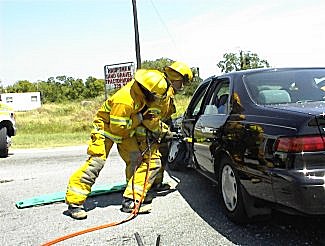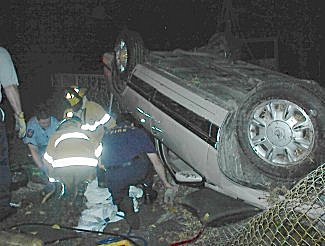By: Mark Pandanell
You arrive on an auto accident with your adrenaline going 900 to nothing! As the engine comes to a stop you are already looking at the vehicles mangled and twisted. You see people with panicked looks on their face as they are pointing to one of the vehicles across the roadway. Knowing someone must be severely hurt; you bail out of the engine and head across the roadway. Then in a blink of an eye, WHAM….you become a victim yourself. A vehicle whose driver was paying more attention to the wreck than looking ahead has struck you.
This type of scene happens across America on a daily basis. With car wrecks happening at an alarming rate, firefighters must constantly maintain control of scene safety. The odds of getting injured or killed in a nighttime collision are drastically increased due to the flashing lights on emergency vehicles. From the fire engine to the ambulance, even from the police cars with every vehicle parked at different locations. The lights can disorientate everyone on scene including civilian vehicles that are approaching the scene or trying to make their way through. Firefighters are also in extreme danger during heavy rain, snow, fog or any poor weather condition. A slick roadway due to any of these conditions can be very dangerous. A driver disorientated from the flashing emergency lights might not judge the distance to well. Then due to a slick roadway from any of the conditions above, the driver might hit his or her brakes to hard and slide into the scene.
Here are a few ways to
control the scene when you first arrive:
1. Always look before you exit your engine and cross a roadway
2. Set up flares as soon as possible
3. Get bystanders away from the scene
4. Park the apparatus in a manner to block the roadway
There are also other life hazards that exist at a MVA also. How many times
have you approached a mangled vehicle only to discover a pole has been hit
and wires laying everywhere. Then see civilians that stopped to help before
you arrived walking all around the wires. Some trying not to step on them,
others not even realizing what they are doing. Now you are faced with getting
them to safety before you end up with more patients. The best approach here
is to establish scene safety and ask all civilians to move away from the scene.
Let's look at some of
the tools and special equipment that should be carried on a fire truck or
rescue vehicle.
1. Jaws of life
2. Hydraulic cutters
3. Airbags
4. Cribbing
5. Hydraulic rams of two different sizes
6. Oxyacetylene Torch
7. Battery operated Sawzall
8. Windshield cutting tool
One must keep scene safety in mind at all times during the operation of the jaws, airbags, cutters, cribbing and the other tools that are required to free victims. The hydraulic tools are the most dangerous and can severely hurt a firefighter. The firefighter who uses these tools should be wearing full firefighter turnout gear. Including a helmet, with shield down and safety glasses. Some will choose to put on the latex gloves first, and then heavy gloves next. The latex gloves will protect the firefighter from any gasoline, oil, blood or body fluids that might pass through the outer gloves.
The "Jaws of Life" is the most common tool used at MVA's. It is the most recognizable in the civilian community. This tool can be extremely dangerous when improperly used. Most jaws tools also have cutters built into the spreader arms. Use of the jaws should be a 2-person operation.

Photo shows the proper use of the jaws as well as the proper protective clothing
If not properly placed,
the jaws can pop out with tremendous force. One also has to protect the victim
during the use of the jaws. Always stand to the back of the door you are trying
to pry open. Doors can fly open under extreme force as pressure on them from
the wreck and jaws is released.
The hydraulic ram is powerful as it pushes with thousands of pounds of force.
This can be dangerous for anyone around it. There was an instance where the
author pulled up on a 2 car MVA while riding Engine 16. We removed the 2 front
doors, the roof and were about to place the large ram so we could roll the
dash area off the victim's legs. A paramedic from the ambulance company rushed
in and wanted to start an I.V. line on the victim's arm. The paramedic had
good intentions, though should have waited for us to finish extrication. I
asked him to move back while I rolled the dash to free the victim. He was
persistent on starting the I.V. line on the victim. He stated to me that he
had his legs up against the ram and it wasn't going anywhere. I told him that
the ram uses thousands of pounds of pressure and that if it were to break
loose for any reason then his legs would be toast. Rams can cut loose or the
part of the car you are pushing on might give way. When these things happen,
firefighters and others can get seriously injured or killed.
1. You should place the
ram in an area as solid as possible on both ends.
2. Always clear non-essential personnel away while you are working the ram.
3. Before deploying the ram, make sure the victim is protected. You can use
a short
backboard between victim and ram.
4. Cover the victim with a blanket or sheet.
Airbags and cribbing are by far the most dangerous that comes to mind. Vehicles that are turned over, lying on their sides, or on top of one another can be extremely unstable. A firefighter should not try to gain entry into one until they have been completely stabilized. As a firefighter begins to stabilize a vehicle, he must be on constant alert for any movement that might lead to the vehicle becoming a life hazard for everyone around. It is always a good thing to leave someone in charge that can constantly maintain watch over the vehicle while others are extricating the victim. One must always keep watch over the cribbing and airbags to check for any movement, such as sinking into the ground, collapsing or deflation of the airbags.

2 airbags placed on top of one another under the front wheel area. A firefighter
also places more cribbing under the car as he watches for any movement.
Complacency can lead
to dangerous situations for any firefighter that has been on the job for a
few years. I have been with my department now for over eight years and have
made countless car wrecks. After awhile complacency will try to set in.
Once again you pull up to a car wreck, one that you have made a dozen times.
You see it as any other car wreck. You get used to things, the jaws, airbags,
cribbing and so forth. You get complacent. You have never had a car roll over
or fall once you have blocked it up. You get complacent. Doors have been just
popping off with the jaws, maybe once one came off with tremendous force,
though not hurting anyone. You get complacent. You have never really seen
anyone step on a downed wire or seen that leaking fuel actually catch ablaze.
You get complacent. The police officers always have traffic stopped while
you do your job. You get complacent.
Then it happens, a wire electrocutes you, leaking fuel bursts into flames,
a ram breaks loose, a door pops off the wrong way with tremendous force, cribbing
or airbags give way and the vehicle falls, or a vehicle with a driver approaching
to fast not paying attention strikes you.
You or another firefighter on scene is now seriously injured or dead…complacency.
You should never let complacency set in on the job. There are many life hazards that a firefighter will face at car wrecks. It is up to you and other firefighters to recognize the hazards and apply scene safety. Treat every car wreck with respect.
Take scene safety seriously; watch out for your fellow firefighters also. Teach the rookies scene safety, make them learn it.